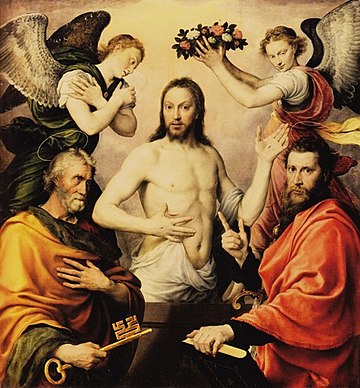A blessed solemnity of Saints Peter and Paul! They were comites, as they say in Latin, companions in life and in death, martyred under the diabolical tyrant Nero sometime between 64 and 68 Anno Domini. Counting the years from Our Lord’s birth did not become a thing until Dionysius Exiguus began the practice in Scythia Minor in 525. So in contemporary reckoning, it would have been around 820 A.U.C., ab urbe condita, or just over eight centuries from the legendary founding of Rome. Peter went first, according to Saint Augustine – unlike his second-place finish in his race to the tomb with John – and Paul followed soon afterwards,
Peter was, according to tradition, crucified upside-down, not considering himself worthy to die in quite the same manner as his Lord, Who had predicted three or so decades earlier to His first Vicar that in due they would bind him and lead him where he would rather not have gone. Simon Peter had earlier denied his Lord three times out of fear. Repenting, he then confessed his love three times – albeit imperfectly – for His Saviour. Now that he had that perfect love which casts outs fear, Peter went boldly forth, into the very den of the lion, defying the authority of the first of many ‘anti-Christs’ in the corrupt regime of Nero.
Paul was at first given a not-too-uncomfortable prison, as we read at the end of Acts, from which he preached, wrote and helped to direct the burgeoning Church until he too met his end with the swift stroke of sword; he was spared crucifixion, being a Roman citizen. After the death of the two Apostles, Nero began his fanatical and demonic persecution of the ‘Christians’, whom the Romans ironically called atheists, as denying their ‘gods’.
Nero considered himself quasi divine, as would many of the later emperors, and he would brook no rivals: The deviant, red-bearded tyrant tried to kill God by murdering, torturing, burning alive, his disciples. Hence, the ‘martyrs of Rome’, whose feast we celebrate the day after Peter and Paul.
Nero went to his own death but a year afterward the glorious Apostles, as his reign dissolved, and city of Rome along with him, in flames. It was likely he played the lute, not the violin (which had yet to be invented centuries later) as the Eternal City burned. Too fearful to take his own life as the enraged mobs closed in, he had his secretary thrust a sword into him, proclaiming, Qualis artifex pereo!, ‘What an artist dies in me!’. We may wonder what he said to the One True God a few moments later, whose little ones he had so abused, tortured, crucified, thrown to the dogs, burned alive, all while he ‘fiddled’.
Nero’s persecution died with him, but, soon enough, as Saint John prophesied, many other antichrists arose, and will do so until the end. But the two Apostles we celebrate today left behind not only their inspired writings, offering us unto the end of time a program for how to live in this world, as though not living herein, but also a glorious example of how to obey God first, Caesar second.
While we are in this battle of life – for we are the Church militant – there are two sides we may trod, as the opening line of the Didache would proclaim – perhaps the earliest non-Scriptural Apostolic teaching that we have: The way of life, and the way of death, and there is a wide difference between them, in their practice and in their fruits, as is becoming rather clear.
We must choose, and choose wisely, boldly and without hesitation.
Are we with Peter and Paul, and their true successors, or Nero’s, and his?

